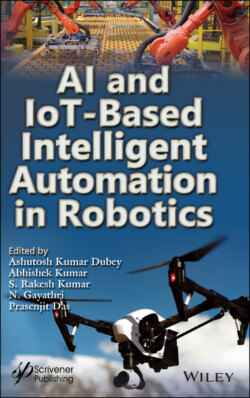Читать книгу AI and IoT-Based Intelligent Automation in Robotics - Группа авторов - Страница 10
Оглавление
Preface
It is widely believed that the current technologies are not the only factors that limits the building of an efficient human-machine intelligent processing engine. The emotions and the cognitive abilities are also playing an important role in understanding the various aspects through various intelligent technologies.
Artificial Intelligence (AI) is one of the trending technologies in the recent era. The emergence of the robotics and application of AI in it brings out a significant change in the domain. Various algorithms that emerge in AI and the computational efficiency of the systems has made it possible to address a number of applications through robotics. The Internet of Things (IoT) is the important domain that plays a major role in robotics. With the aid of IoT and AI, robotics an exponential development in providing solutions to complex technical problems have been explored.
This book aims at providing an overview of robotics and the application of AI and IoT in robotics. It contains the deep exploration of AI and IoT based intelligent automation in robotics. The various algorithms and frameworks for robotics based on AI and IoT have been presented analyzed and discussed. This book also provides insights on application of robotics in education, healthcare, defense and many other fields with the utilization of IoT and AI. It also includes the idea of smart cities using robotics.
This book contains twenty-four chapters. Chapter 1 reports the introduction about the robotics. Chapter 2 explores the techniques of robotics for automation using AI and IoT. Chapter 3 descriptively investigates the role of the defense in the same technological aspects. Chapter 4 examines the role of AI and IoT based intelligent automation of robotics in case of healthcare. Chapter 5 explores the skill transfer to robots based on semantically represented the activities of humans. Chapter 6 illustrates the healthcare robots enabled with IoT and artificial intelligence for old aged patients. Chapter 7 explores the robotics, AI and IoT in defense system. Chapter 8 describes the techniques of robotics for automation using AI and IoT. Chapter 9 discusses an artificial intelligence based smart task responder that is android robot for human instruction using LSTM technique. Chapter 10 explores the robotics, AI and IoT in medical and healthcare. Chapter 11 scrutinizes real time mild and moderate Covid’19 human body temperature detection using AI. Chapter 12 shows the role of drones in smart cities. Chapter 13 presents UAV’s in terms of agriculture prospective. Chapter 14 discussed the semi-automated parking system by using DSDV and RFID. Chapter 15 reviews on the various technologies involved in vehicle to vehicle communication. Chapter 16 explores about the smart wheelchair. Chapter 17 explores defaulters list using facial recognition. Chapter 18 introduces visitor/intruder monitoring system using machine learning. Chapter 19 provides a comparison of machine learning algorithms for air pollution monitoring system. Chapter 20 discusses a novel approach towards audio watermarking using FFT and Cordic Q-R decomposition. Chapter 21 explores the performance of DC biased optical orthogonal frequency division multiplexing in visible light communication. Chapter 22 illustrates the microcontroller based variable rate syringe pump for microfluidic application. Chapter 23 illustrates the analysis of emotion in speech signal processing and rejection of noise. Chapter 24 discusses regarding securing cloud data by using blend cryptography with AWS services.
Overall, this book is designed for exploring global technological information about the AI and IoT based intelligent automation in robotics. Armed with specific usage practices, applicability, framework and challenges readers can make informed choices about the adoption of AI and IoT based intelligent automation. It may be helpful in the development of efficient framework and models in the adoption of these techniques in different domains.
It is a great pleasure for us to acknowledge the contributions and assistance of many individuals. We would like to thank all the authors who submitted chapters for their contributions and fruitful discussion that made this book a great success. We hope the readers find value and future insights into the contributions made by the authors. This book also opens up further avenues and opportunities for the future research. We are very thankful to the team of Scrivener publishing specially to Martin Scrivener for providing the meticulous service for timely publication of this book. We would like to express our deep sense of gratitude for the encouragement and support offered by our Institutions/Universities and colleagues. Last but not least, we gratefully acknowledge the support, encouragement and patience of our families.
Ashutosh Kumar DubeyAbhishek Kumar S. Rakesh Kumar N. Gayathri Prasenjit Das February 2021
